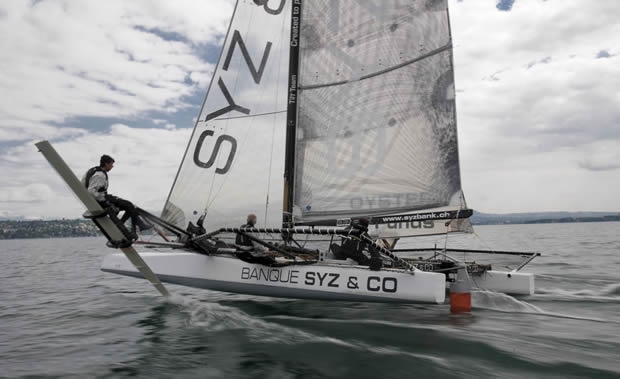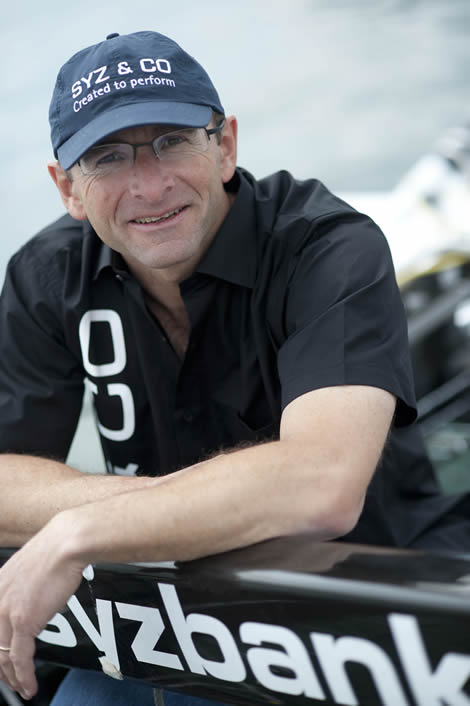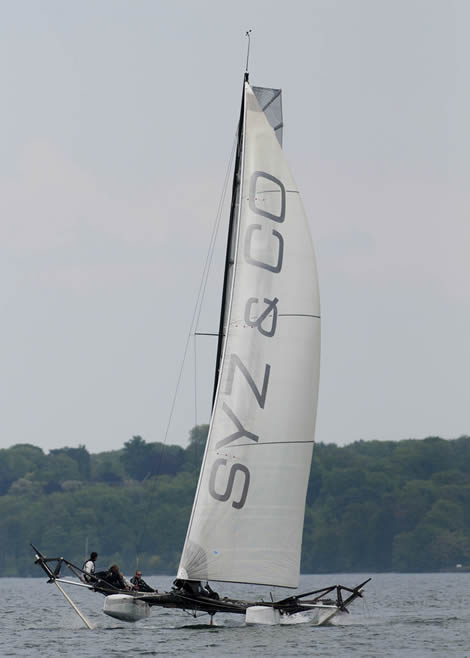
Alinghi experts join Syz & Co hydrofoiler project
Luc du Bois from the Alinghi Design Team, is joining the SYZ & Co hydrofoil catamaran. A performance analysis expert, du Bois is also the co-inventor of 3DL sail technology and is one of the world’s top A Class catamaran sailors. He brings with him Alinghi colleague Daniele Costantini, a fibre optics technology specialist. Their objective for the coming year: to analyse and improve the boat’s performance, in order to take part in the main regattas and beat all of Lake Geneva’s speed records!
The Syz & Co hydrofoil catamaran was relaunched at the end of April in her new white pointjob for a season that appears full of promise, with a new configuration and above all a new team for the prototype conceived by Alex Schneiter, Patrick Firmenich and Jean Psarofaghis and designed by naval architects Van Peteghem – Lauriot Prevost.
Alex Schneiter has known Luc du Bois since they were students: "We spent many good times together sailing and mountaineering, and we continue to take the opportunity to share these two passions whenever we get a chance to do so."
Since Alinghi’s future remains uncertain, du Bois is currently available to strengthen the team. His role is to accelerate and optimise the tuning of the hydrofoil, providing the team with the benefit of his lengthy America’s Cup experience. The first step will be to collect a full set of data with Daniele Costantini, in order to analyse the boat’s performance, in particular with the help of optical fibres placed in the foils. This technology provides measurements of the stress and loads undergone by the catamaran while sailing. The data will allow du Bois to determine how to improve the boat’s performance. "You need to sail for hours and hours to optimize an experimental boat like the SYZ & CO hydrofoil catamaran," du Bois explains. "We have to devote a lot of time to sailing, in particular to establish the boat’s polars with precision."
The schedule this season is to optimise the boat and its performance, then to tackle the lake’s speed records, and potentially also to take part in the main regattas. Patrick Firmenich explains : "Syz & Co represents an important technological challenge and the first step remains to tune up the boat and increase its reliability. It is very fast but we need to improve consistency and versatility. It’s relatively easy to make a boat fly nowadays, but to ensure that it is fast across all wind angles and speeds remains a major challenge from a technological point of view. We still have a lot to learn and a lot of work to do in order to optimize her. Moreover, the wind conditions in the early summer are rarely conducive to flying. During the second part of the season, we’ll tackle the speed records and are aiming at one or several of the Syz & Co Léman Sailing Speed Records."
The catamaran's hulls were extended at the end of last season after one broke during a record attempt in strong winds, have been rebuilt during the winter. Simplifications have permitted a significant weight loss, particularly in the hydraulic system. Finally, a new mast will be fitted, two metres longer than the previous one, at the end of the month and will thus allow a sail area increase in order to improve light wind performance.
"The idea is mainly to make the most of the region’s wind ranges and not necessarily to push the top performance further," says du Bois.
The catamaran will sail with a crew of four, including Alex Schneiter and Patrick Firmenich. Luc du Bois, who is also a mutliple European and World champion, as Arnaud Psarofaghis focussed on his D35 and Moth campaigns this season. The fourth crew member will change depending on the event, but the idea is to significantly increase the number of tests and of hours spent on the water.
"Foil-borne boats are still experimental," continues du Bois. "The only boats of this type which have achieved comprehensive results and which are fast both upwind and downwind are the foiling Moths. For all the others, a lot of analysis still needs to be undertaken and a lot of sailing hours have to take place. Many boats fly, but they are not necessarily fast or only in certain specific points of sail. Adding the vertical dimension to sailing, i.e. flying, means the start of a new era. We are still in its early days and find ourselves just at the beginning of the learning curve."
Ricardo Payro, Head of Communications at Syz & Co concludes: "We are proud to support this adventure, which is both human and technological, helping to write sailing history in real time. Going off the beaten track to invent a new way of sailing is obviously a challenge that cannot be overcome in one day. On the contrary, it requires a large degree of perseverance in order to solve all the problems that inevitably occur. Luc du Bois and Daniele Costantini’s involvement clearly shows the interest this project arouses among top specialists."










Latest Comments
carmitage 21/05/2010 - 14:07
If not on the windward foil, where would you have him? presumably it is less about having the chappy on the windward foil, but NOT on the leeward one, which needs more lift or less downward force (weight plus downward component of sail pressure). The only other position for him would be in the water....gundogger 21/05/2010 - 13:38
What is the point of having that fellow on the windward foil when by immersing more of it, more lift will be generated. It's the leeward foil that needs to be adjusted.The windward foil is working fine as the weather hull is out of the water. Foil-borne cats are notoriously difficult to design!Add a comment - Members log in